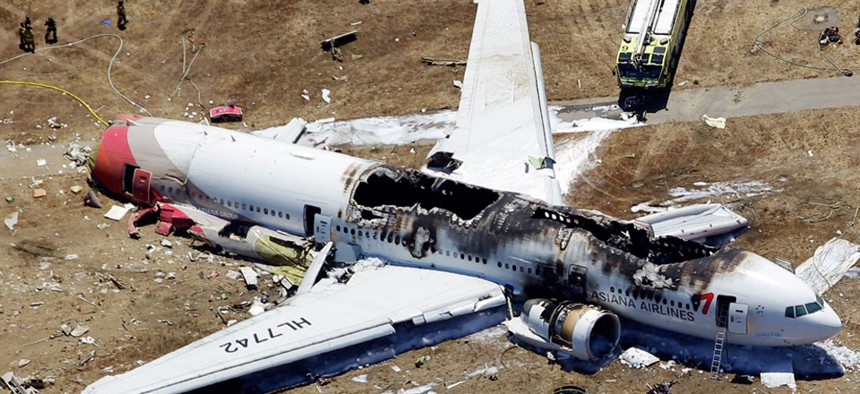
Marcio Jose Sanchez/AP
Leadership Lessons from the San Francisco Plane Crash
Just because team members are experienced, does not mean the team will automatically succeed.
My friend and Georgetown leadership coaching colleague, Bob Wohlsen, sent a thought provoking email to his friends and clients last week on the recent crash of an Asiana 777 jet liner at San Francisco International Airport. In it, Bob raises a lot of important questions for leaders and their colleagues to consider. With his permission, I’m sharing his thoughts on the Next Level Blog. You can learn more about Bob and his work with leaders as well as contact him through his LinkedIn profile.
A few Saturdays ago, I was happily engaged around our house in the Bay Area, when I received an AP alert on my iPhone. I was stunned to read Plane Crash at SFO. I hurried to our deck, where Miriam and I often enjoy watching the huge jet liners turn, line up with the runway, and descend to the airport. I was horrified to see a cloud of black smoke drifting over San Francisco Bay. As I soon learned, Asiana Flight 214 had clipped the seawall at the end of the runway and crashed. It was a tough afternoon to know of the pain and suffering going on nearby.
So, while the extremely capable NTSB teams are combing the wreckage, analyzing the data, and interviewing the crew to determine what went wrong and how to prevent it from happening again, I’ve been musing about what leadership lessons we can learn from the tragedy. Here’s what I’ve learned, based on the information I’ve obtained from news reports and the NTSB briefings:
- There was a team of 3 experienced pilots in the cockpit at the time of the crash. The pilot flying the plane had little experience flying the Boeing 777. He had never landed a 777 at SFO. He was the “student” pilot on this team. His “instructor”, the co-pilot, had more experience flying the 777, but this flight was his 1st as an instructor. The third pilot in the cockpit sat in the jump seat.
- There was a 4th pilot in the passenger cabin at the time of the crash.
- The “instructor” pilot has testified that he assumed that the automatic throttles were maintaining the plane’s speed at the proper level.
- The day was very clear, the wind was gusty (typical, but tricky if you are new to it here), and the 777 has an extremely high safety record.
The fact is that a safe, sturdy plane crashed with 4 experienced pilots on board on a clear day. Why did this happen? How could this have happened? Here is my hunch:
- Although the pilots were all very experienced aviators, each had only a little experience flying the 777.
- The pilot team was working as a team for the 1st time in these roles and with this plane.
And I have these unanswered questions in my mind. Did the team organize effectively – delineate clear roles and responsibilities, establish a working arrangement including a communications plan, feedback plan, and decision making plan? Was there a clearly designated and recognized leader of the team? Did the team members know each others’ preferences for communication and feedback or the individual needs of each other?
The NTSB investigation will provide answers to these questions.
What are the takeaways for us, as leaders, and our teams?
- Just because team members are experienced, does not mean the team will automatically succeed.
- Team organization is essential to a team’s ability to successfully achieve its goal.
- There must be a person leading, setting expectations and holding team members accountable, who has their eye on the goal (landing the plane safely) and is monitoring (looking at the data and metrics) and evaluating the data and the team members’ performance.
- All team members must look out for each other, communicate, challenge, and collaborate to prevent accidents, mistakes, and failures.
What additional takeaways do you see? What learning is there for you and your teams in this accident? What can you do to improve your team’s performance, and reduce the risk of accidents and failures?







